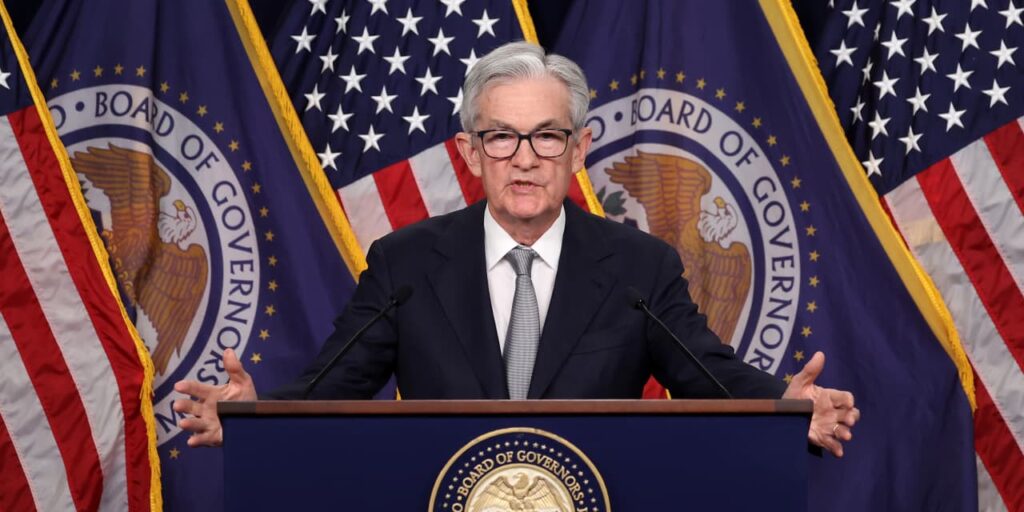Federal Reserve Chair Jerome Powell is set to participate in back-to-back discussions Friday. Investors will be eagerly watching for signals that the U.S. central bank head and fellow policy makers are ready to call an end to interest-rate increases.
Powell will speak with Spelman College President Helene Gayle at 11 a.m. Friday, during a fireside chat focused on the challenges of the post-Covid economy in the U.S. That will be followed by a roundtable discussion, also at Spelman College, with Powell and Fed Governor Lisa Cook at 2 p.m. on Friday.
The latest economic data seem to show slowing economic momentum in the fourth quarter, a cooling labor market, and retreating inflation. And so markets are anxiously watching for Powell to stop reiterating the message that the Fed is prepared to hike further—a theme he’s consistently touched on in since the last quarter-point hike implemented in July.
Markets and Fed officials have been having a bit of an economic forecasting battle in recent months. Investors have fairly consistently favored fewer rate increases and an earlier end to the hiking cycle, while policy makers have remained far more cautious, stressing the risks associated with prematurely declaring victory in the fight against elevated inflation. Powell will likely to continue to echo that sentiment in Friday’s discussions. Yet with the Federal Open Market Committee set to meet Dec. 12-13, there’s currently a 96.1% probability that officials keep the benchmark rate steady at the current 5.25% to 5.50% at the conclusion of the meeting, according to the CME FedWatch Tool.
Friday’s discussions cap off a busy week of appearances by Fed officials, who have delivered mixed messages. John Williams, the president of the Federal Reserve Bank of New York, struck a more middle-of-the-road tone on the current state of inflation in comments he delivered Thursday. In comparing inflation to an onion with many layers, Williams said monetary policy has reached a restrictive enough level that it’s working to bring demand into balance with supply, and inflation back to the Fed’s 2% longer-run target. But he stressed that if imbalances persist, he isn’t ruling out additional policy firming as needed.
“Since I first started to unpeel the inflation onion a year ago, we have seen meaningful progress on bringing inflation down and restoring balance to the economy. But our work is not nearly done,” Williams said.
Richmond Fed President Tom Barkin is less certain that conditions have reached a level needed to sustainably bring down inflation, which remains well above the target. Thursday’s release of the Fed’s preferred inflation gauge, the core personal-consumption expenditures Price Index—which excludes the more volatile food and energy costs—slowed to a 3.5% year-over-year pace in October, down from 3.7% a month prior and in line with expectations.
Barkin, in an appearance at the CNBC CFO Council Summit on Wednesday, said point-blank he wouldn’t take another interest-rate hike off the table, noting he’s skeptical that conditions are at the level needed to achieve the 2% goal.
“I’m still in the looking-to-be-convinced category rather than the convinced,” Barkin said. His base case is that inflation will continue to come down, but it’s going to come down “stubbornly.” In the end, he expects that the U.S. will have some sort of slowdown.
“As the rates work their way through the economy in the way that they’re supposed to, they will have the impact. I mean, it’s not like somebody’s changed the way the economic model works. And when they do, you’ll have some slowdown,” Barkin said at the summit.
Earlier this week, Fed Governor Michelle Bowman similarly said she continues to see evidence that it might be necessary to raise rates further. While she supported the FOMC’s decision to hold the benchmark federal-funds rate at 5.25% to 5.50% during its November meeting, she continues to expect the Fed will need to increase it.
“I remain willing to support raising the federal-funds rate at a future meeting should the incoming data indicate that progress on inflation has stalled or is insufficient to bring inflation down to 2% in a timely way,” she said Tuesday, in remarks to the Utah Bankers Association and Salt Lake Chamber.
Atlanta Fed President Raphael Bostic, on the other hand, said he increasingly sees a case for continued disinflation, according to an update published Wednesday.
“The good news is that, in the view of most of our contacts, activity is decelerating but not dramatically enough to portend a destructive economic downturn,” Bostic wrote.
Similarly, Fed Governor Christopher Waller said Tuesday he’s outright optimistic that the current level of interest rates is restrictive enough to slow down the U.S. economy in a way that brings inflation down.
“As long as we don’t get any big shocks, I am reasonably confident that we can pull off this soft landing,” he said.
Despite the seemingly conflicted outlooks, Fed policy makers were in agreement this week that it’s too early to discuss cutting interest rates. Barkin noted that if inflation and the underlying indicators of price growth remain elevated, there’s no case for lowering rates.
“If you believe, as I believe, that inflation is going to be more stubborn than I would like it to be, then I think talking about reducing rates at this point is just premature,” Barkin said.
Expect Powell, if he even addresses the topic, to similarly dismiss the idea that Fed officials are seriously discussing rate cuts at this point. There’s even a fair chance he never even organically utters the word “cuts” in Friday’s discussion.
Friday’s fireside chat with Federal Reserve Chair Jerome Powell will start at 11 a.m. ET, followed by a roundtable discussion at 2 p.m.
Write to Megan Leonhardt at megan.leonhardt@barrons.com
Read the full article here

